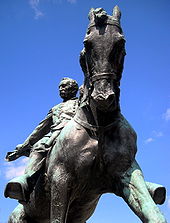Winchester (horse)
| Winchester | |
 Rienzi / Winchester |
|
| Race: | Morgan |
| Father: | |
| Mother: | |
| Mother, father: | |
| Gender: | |
| Year of birth: | 1860 |
| Year of death: | 1878 |
| Country: | United States |
| Colour: | Black |
| Owner: | Philip Sheridan |
| Equestrian: | Philip Sheridan |
Winchester alias Rienzi (* 1860 , † 1878 ) was a well-known riding horse of General Philip Sheridan in the American Civil War .
Life
General Sheridan received the horse as a gift from officers of the Second Michigan Cavalry in 1862. It was initially named after the place of delivery, Rienzi (Mississippi). It was renamed after Sheridan rode it from Winchester, Virginia to Cedar Creek on October 19, 1864 , in order to turn an almost certain defeat into a victory. This twenty mile ride became known as Sheridan's Ride and was artistically glorified several times.
Whereabouts
After his death in 1878, Winchester was groomed and stuffed. Sheridan gave the stuffed horse to the Military Service Institution's Museum in New York. This gave Winchester's remains to the Smithsonian in 1922 after a fire that did not damage the exhibit . The stuffed horse was bid farewell in the presence of ten veterans and in a festive setting on Governors Island . It now stands in the Armed Forces History Hall in the National Museum of American History in the Behring Center in Washington, DC Winchester is stuffed in motion in what is supposedly his head-high posture. He wears his original saddle and the accompanying bridle.
Artistic reception


The heroic ride of Sheridan and Winchester, which, according to legend, led to the victory of the northern states in the battle of Cedar Creek, was turned into the ballad Sheridan's Ride by the poet Thomas Buchanan Read in 1864 . In 1871, Read painted a double portrait of Ross and Reiter for the Union League of Philadelphia , which is on display in the National Portrait Gallery of the Smithsonian Institute in Washington DC. In 1886 the Swedish-American illustrator Thure de Thulstrup (1848–1930) took on the subject in an illustration. The sculptor John Gutzon de la Mothe Borglum created an equestrian statue of Sheridan and Winchester for Sheridan Circle in Washington, DC in 1908
Legends about the beast
There are apparently numerous legends surrounding Winchester's life, death and whereabouts. Bill Nye said he had gathered information about the animal. Kentucky as well as Pennsylvania and Michigan were named as the countries of origin , he also heard statements about the cremation of Winchester in New Orleans , about a resuscitation of the dead horse and several other stories. Overall, he could say that this noted beast died in nine different states and was buried in thirteen different ways.
literature
- Jack H. Lepa: The Shenadoa Valley Campaign of 1864. McFarland & Co, Jefferson NC 2003, ISBN 0-7864-1644-0 , pp. 200 f.
Individual evidence
- ↑ http://www.smithsonian.org/Encyclopedia_SI/nmah/horse.htm
- ↑ http://www.smithsonianlegacies.si.edu/objectdescription.cfm?ID=105
- ↑ http://historywired.si.edu/object.cfm?ID=527
- ↑ http://query.nytimes.com/mem/archive-free/pdf?_r=1&res=9B02E2D91439EF3ABC4D53DFB0668389639EDE
- ↑ http://www.si.edu/encyclopedia_SI/nmnh/famehors.htm
- ↑ http://www.civilwar.si.edu/cavalry_winchester.html
- ↑ http://www.horsehints.org/WashingtonDCHorseStatues.htm
- ↑ http://www.authorama.com/remarks-b-38.html
Web links
- Warhorse Rienzi (1860–1878) , biography on the findagrave.com portal
